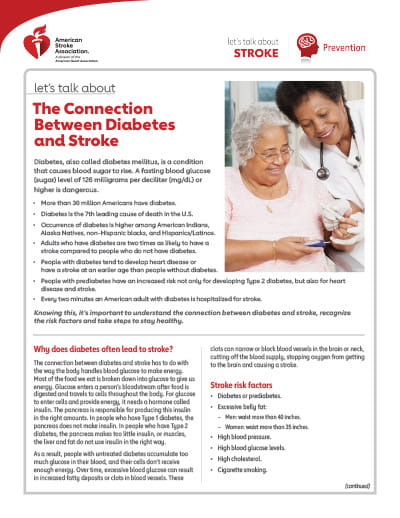Let’s Talk About the Connection Between Diabetes and Stroke
 Diabetes, also called diabetes mellitus, is a condition that causes blood sugar to rise. A fasting blood glucose (sugar) level of 126 milligrams per deciliter (mg/dL) or higher is dangerous.
Diabetes, also called diabetes mellitus, is a condition that causes blood sugar to rise. A fasting blood glucose (sugar) level of 126 milligrams per deciliter (mg/dL) or higher is dangerous.
- More than 30 million Americans have diabetes.
- Diabetes is the 7th leading cause of death in the U.S.
- Occurrence of diabetes is higher among American Indians, Alaska Natives, non-Hispanic blacks, and Hispanics/Latinos.
- Adults who have diabetes are two times as likely to have a stroke compared to people who do not have diabetes.
- People with diabetes tend to develop heart disease or have a stroke at an earlier age than people without diabetes.
- People with prediabetes have an increased risk not only for developing Type 2 diabetes, but also for heart disease and stroke.
- Every two minutes an American adult with diabetes is hospitalized for stroke.
Knowing this, it’s important to understand the connection between diabetes and stroke, recognize the risk factors and take steps to stay healthy.
Why does diabetes often lead to stroke?
The connection between diabetes and stroke has to do with the way the body handles blood glucose to make energy.
Most of the food we eat is broken down into glucose to give us energy. Glucose enters a person’s bloodstream after food is digested and travels to cells throughout the body. For glucose to enter cells and provide energy, it needs a hormone called insulin. The pancreas is responsible for producing this insulin in the right amounts. In people who have Type 1 diabetes, the pancreas does not make insulin. In people who have Type 2 diabetes, the pancreas makes too little insulin, or muscles, the liver and fat do not use insulin in the right way.
As a result, people with untreated diabetes accumulate too much glucose in their blood, and their cells don’t receive enough energy. Over time, excessive blood glucose can result in increased fatty deposits or clots in blood vessels. These clots can narrow or block blood vessels in the brain or neck, cutting off the blood supply, stopping oxygen from getting to the brain and causing a stroke.
Stroke Risk Factors
- Diabetes or prediabetes.
- Excessive belly fat:
- Men: waist more than 40 inches.
- Women: waist more than 35 inches.
- High blood pressure.
- High blood glucose levels.
- High cholesterol.
- Cigarette smoking.
What You Can Do
If you have diabetes, you can ward off the risk of stroke by taking steps to keep your heart and blood vessels healthy.
- Maintain a heart-healthy diet.
- Don’t smoke.
- Maintain a healthy weight.
- Exercise every day.
- Limit alcohol.
- Learn to manage stress.
- Talk to your health care provider.
Be Informed, Be Healthy
People with diabetes can live long, healthy lives, free from heart disease, stroke and other health problems. Recognizing the connection between diabetes and stroke is the first step toward lowering stroke risk.
How can I learn more?
- Call 1-888-4-STROKE (1-888-478-7653) or visit stroke.org to learn more about stroke or find local support groups.
- Sign up for our monthly Stroke Connection e-news for stroke survivors and caregivers at StrokeConnection.org.
- Connect with others who have also had an experience with stroke by joining our Support Network at stroke.org/SupportNetwork.
Do you have questions for the doctor or nurse?
Take a few minutes to write down your questions for the next time you see your health care provider. For example:
How can I reduce my risk of stroke?
We have many other fact sheets to help you make healthier choices, manage your condition or care for a loved one.
Visit stroke.org/LetsTalkAboutStroke to learn more
© Copyright 2020 American Heart Association, Inc., a 501(c)(3) not-for-profit. All rights reserved.
American Stroke Association is a registered trademark of the AHA. Unauthorized use prohibited. DS15728 1/20